10 Best Tips for Wearing Heels Over 65 From Doctors and Style Experts
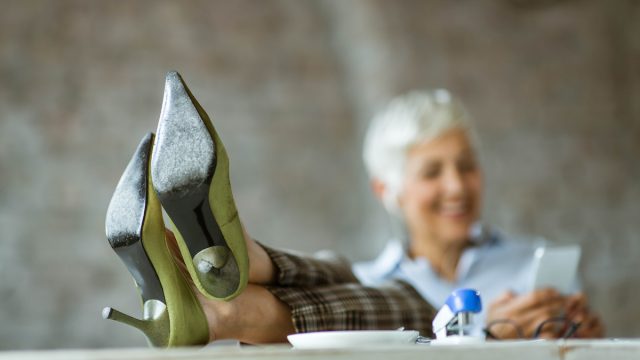
While heels may no longer be de rigueur for looking put-together, they’re still the preference of many women looking for height and polish. However, those in their 60s and beyond may feel that they can’t comfortably wear the higher-heeled shoes they favored decades ago. Luckily, this is not the case.
Daniel Pledger, podiatrist and founder of ePodiatrists, notes that, yes, “heels can lead to bunions, hammertoes, and other deformities of the feet.” He also says that if you have any existing foot conditions, such as arthritis or diabetes, “it’s even more important to be careful when selecting shoes.”
However, Pledger says not to pay attention to the general myths “that you should only wear flats after a certain age or that Birkenstocks are the only ‘comfortable’ shoes.” You can still wear a heel “as long as you choose shoes that fit well and offer support.”
Keep reading for top-notch advice from stylists and podiatrists on wearing heels over 65, from the best styles to how you should care for your feet.
RELATED: 6 Tips for Wearing Flats If You’re Over 60, According to Stylists and Podiatrists.
1
Consider heel height.
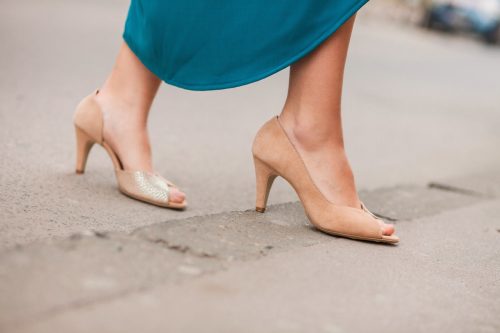
If you want to protect your feet as you get older, you may want to trade in your stilettos for a heel that’s a bit more modest in height.
“Consider a one- to two-inch heel height for more stability,” recommends Derek Roach, owner of orthopedic and comfort shoe company Flow Feet Orthopedic Shoes. “Anything higher compromises on stability and can add more strain to your feet and ankles. Also, there will be more pressure on the forefoot which can lead to corns or callouses.”
2
And heel diameter.
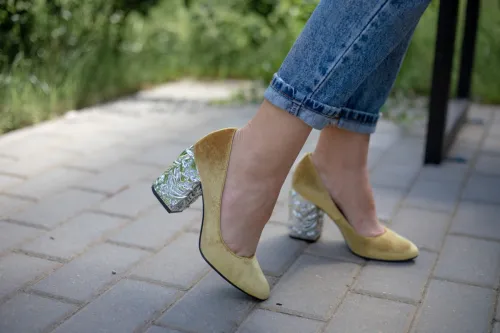
Not only are stiletto heels sky-high, but they’re super-skinny, which can make balancing very challenging.
“A chunky heel can you give you more height without the strain on your body,” says Liza Egbogah BSc, DC, DOMP, a celebrity chiropractor, osteopath, posture expert, and shoe and handbag designer. “Avoid stiletto heels and choose heels that have at least a 1cm diameter for more stability.”
RELATED: 4 Types of Sandals You Should Never Wear After 60, Podiatrists and Stylists Say.
3
Also note the placement of the heel.
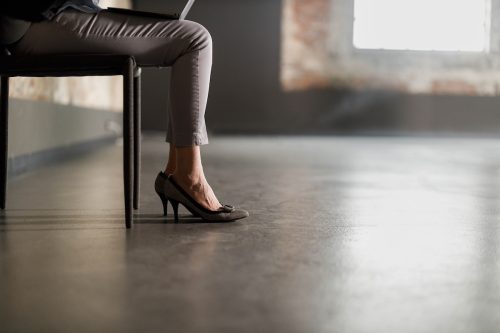
Regardless of what heel height you’re going for, stay away from shoes where the heel itself is all the way at the back end of the shoe.
“If your heel is pressed to the back of your shoe, and there’s a significant gap between your heel and the ball of your foot, your balance will be significantly reduced,” according to Jonny Gilpin of UK footwear retailer Schuh.
4
And the toe box.
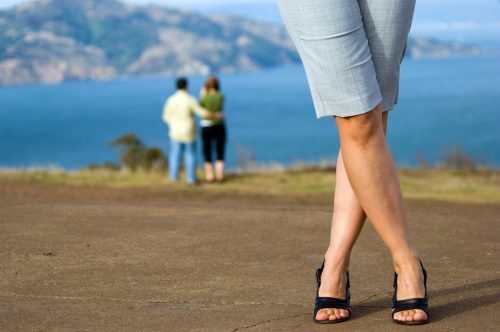
Pointy-toed heels are undoubtedly chic, but they may be doing more harm than good for your feet.
“Heels that have too narrow of a toe box can cause discomfort and over time lead to other foot problems like plantar fasciitis, hammertoes, or bunions,” explains Roach. “Choose a heel with a rounded toe box to allow your feet to spread out naturally for better foot alignment and reducing pressure points on the forefoot.”
Another great option, especially in the warmer months, is an open-toed heel. “Oftentimes these can be more comfortable than closed-toe pumps,” shares Melony Huber, a stylist/buyer, fashion expert, and co-founder of La Peony.
RELATED: 5 “Comfortable” Shoes That Are Actually Bad for Your Feet, Podiatrists Say.
5
Try wedges, platforms, kitten heels, and booties.
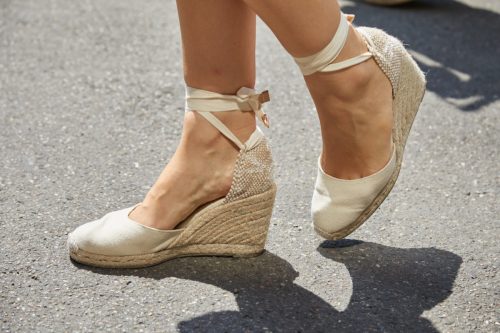
Margaret Manning, the founder of the blog Sixty and Me, knows women love heels because they elongate the legs, make clothes look good, and encourage good posture. But if your stiletto days are over, she offers several alternatives in a Youtube video.
A “nice and sturdy” option, she says, is wedges. “You can wear them with dresses, tunics, pants, jeans…whatever you want. A light-colored wedge, like a cream or skin color, gives you that beautiful effect, it elongates the leg.”
Manning says kitten heels are nice, but they only work with certain clothing that doesn’t overshadow the footwear. “You can’t wear a really chunky trench coat or a heavy-looking outfit.” Instead, she suggests a little evening dress or tighter ankle pants that don’t make the leg look out of proportion to the shoes.
Egbogah also recommends a “classic dressy short-heeled boot,” which she says can be worn with everything from dresses to jeans. “These are the most stable heels you can wear.”
Platforms are another smart choice. Since they’re nearly flat on the bottom, they provide height with none of the instability of heels. “Although they may take some getting used to, platforms offer both style and comfort in equal measure,” says Caitlyn Parish, founder and CEO of bridesmaids’ fashion label Cicinia.
6
Try sizing up.
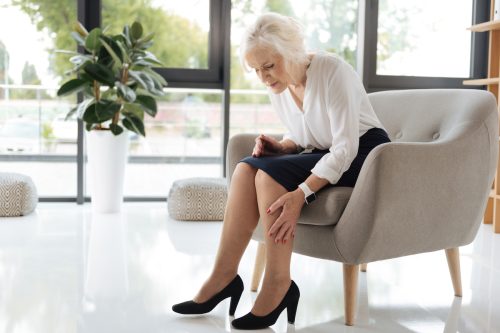
Your shoe size in heels may not be the same as it is in sneakers or sandals.
To get the best fit, Abby Towfigh, a Santa Monica, California-based podiatrist, explains in a YouTube video that it’s smart to go shoe shopping after 5:00 p.m. “You want to go when you’ve been on your feet all day long. You’re swollen so you don’t have to guess, ‘Well, maybe I should get it a little bit looser.'”
That said, you still may want to size up half a size or a full size, notes Holly Chayes, a personal style coach and consultant. “This can give your feet room to swell and avoid any uncomfortable pinching.”
In addition, consider if you’ll be wearing your heels with socks or hosiery and how that will factor into the size you select.
RELATED: The 5 Best Pairs of Heels to Wear With Jeans, According to Stylists.
7
Look for supportive designs.
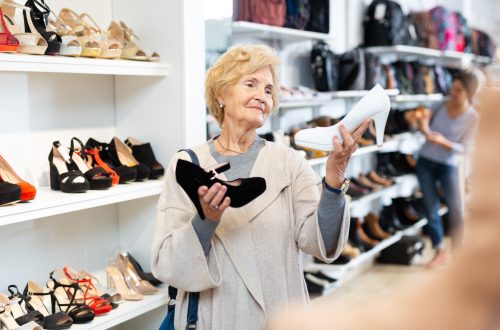
“As we age, we lose some of the cushiony fat pads in our feet and our arches start falling,” explains Egbogah.
That’s why Roach suggests looking for heels that offer a contoured insole design and arch support. “There are many styles available now that use supportive insole and cushioning to optimize your foot health in heels,” he says.
Another supportive feature is ankle straps, notes Egbogah. These will provide more stability to your foot and ankle and thereby improve balance.
8
Add comfort aids.
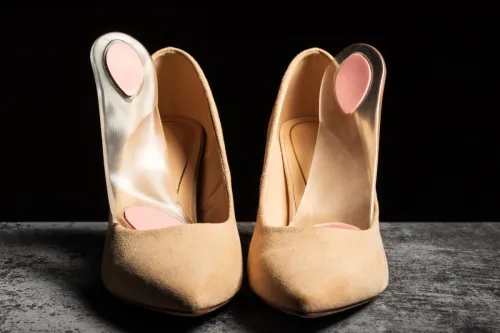
Already own a pair of heels that are so pretty yet so painful? Shoe pads and other cushy additions can really help in the comfort department.
If the problem is in the ball of your foot, Towfigh recommends adding “pads that are made out of silicone that is gelatinous and soft.” For open-toed heels specifically, she says a trick is to have a shoemaker slip a cushy pad under the sole liner, so it can’t be seen. In both cases, she says the pad “will give you more even weight distribution… that way you’re not going to be pushing all of your weight to the ball of your foot.”
Another solution is heel protectors. Becca Brown, the creator of the shoe and foot care brand Solemates, says they “increase the surface area on the base of the heel so you don’t sink into grass or other unsupportive surfaces, and they provide additional traction and stability with the wider surface area.”
Other products Brown points to are heel guards, “which ensure you don’t step out of your heel,” and anti-skid pads that “provide more traction and grip as you walk in high heels.”
There is even a comfort aid for bunions, which tend to grow with age on the joint where your big toe meets the rest of your foot. Of course, finding shoes that don’t hit and rub this area is vital, but Towfigh says you can also buy silicone pads that slide over the big toe to cushion and protect the bunion-prone bone.
For more style and wellness advice delivered straight to your inbox, sign up for our daily newsletter.
9
Break heels in properly.
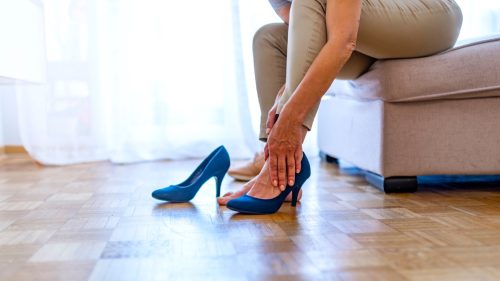
Wearing a brand-new pair of heels straight out of the box to a wedding or all-day affair can easily be a recipe for disaster. This is why stylists and doctors alike recommend breaking the shoes in properly.
“Always break in new shoes gradually–don’t wear them for long periods of time right out of the box. Wear them around the house for an hour or so each day until they start to feel more comfortable,” advises Pledger.
From an economic standpoint, Chayes says it’s quality over quantity. “Instead of having lots of heels in your closet, consider a smaller selection of high-quality shoes that you break in and get comfortable wearing.”
10
Stretch!
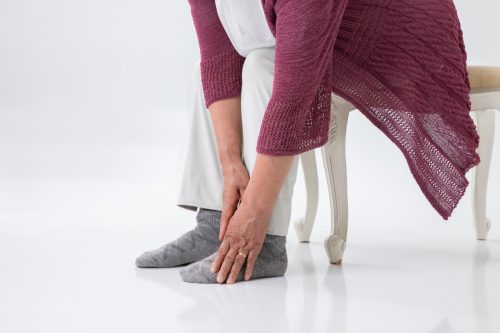
The work isn’t done once you take your heels off. “Stretch your feet and calves before and after wearing heels to help prevent pain and discomfort,” advises Pledger.
“Perform stretching exercises for the legs with the knees flexed and extended, as heels can cause muscles and tendons to tighten excessively leading to tendonitis with sudden change in heel height,” explains Elizabeth Bass Daughtry, DPM, FACFAS, a board-certified podiatric surgeon at Foot and Ankle Specialists. She also recommends massaging feet and legs after wearing heels.